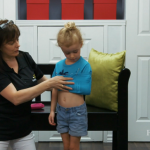

- 27 April 2024
- |
- Andrée Bouchard
Loving your child means giving him everything he needs to grow and flourish. Love, care, resources… and even limits!
Adults sometimes find it difficult to say no to a child, for all sorts of reasons: to please them, to avoid a crisis or buy peace, to get out of guilt for a broken promise, to bargain, or even out of rejection of an overly authoritarian upbringing.
A child who has never been given guidelines will have difficulty accepting the rules of life in general: laws, regulations, social conventions and so on. He or she will then tend to express anger, violence or depression.
Why is it so important to know how to say no to your child?
Some people believe that letting children decide everything helps develop their sense of autonomy. But nothing could be further from the truth. If the adult says yes to everything, the child becomes a slave to the emotion of the moment. Contrary to what you might think, the child who decides everything is not in control, and is not in charge. It’s their emotional state or impulsiveness that has the upper hand. When his desires are satisfied on the spot, he loses his freedom of choice. For example: if the child only wants to eat pasta and the adult doesn’t say no, he won’t force himself to make other choices, and deprives himself of the opportunity to discover other foods and flavors. They become prisoners of their own desires.
Children who are never told “no” become prisoners not only of their own desires, but also of their own fears. Often, the child’s request reflects a fear of moving forward or making a mistake. For example, the child who asks his parent to stay with him at daycare, or who cries to keep his parent at daycare. By saying “yes” to everything, the adult feeds and reinforces the child’s fears. Although it’s hard for parents to say no and see their children cry when they leave, they must stand firm. Refusal forces the child to look for new solutions and possibilities. He learns to call on his own resources, such as trusting another person, bonding with friends, finding strategies to manage his grief and discovering that he can have fun without his parent. If he hadn’t been told “no”, the child wouldn’t have known this was possible. It’s only in this way that children eventually develop skills and autonomy.
Children must learn that they can’t have everything right away. To become an adult, they must learn to wait. It’s a fact of life that they need to assimilate if they are to be happy, and also if they are to be able to invest energy in a project that may take a long time to achieve, such as going to school or getting a driver’s license. And it’s by refusing the urge to say yes right away that adults instill in children the ability to wait.
When to say yes or no?
Having trouble deciding whether to say yes to a child’s request? Here’s a little tip to help: when a child asks for something, remember that he’s expressing either a desire or a need. Since the adult’s role is to respond to the child’s needs first, it will be easier for you to determine whether to say yes or no. For example: it’s 4:30 p.m. and the child asks you for chocolate cookies. You say no, because it’s almost time for dinner. The child replies that he’s hungry and it’s a crisis… Hunger is a need, but the chocolate cookie is a desire. You could therefore recognize the child’s need by offering him a piece of cheese or a raw vegetable. If he accepts, you’ve met his need. If he refuses, maybe he wasn’t that hungry. In the end, you’ll have taught him that you’re capable of saying yes, but within the limits of what you consider acceptable.
When is it wrong to say no?
No” is toxic when it is used to take power over the child or to impose a vision on him/her, rather than to educate and help him/her grow. It’s a power play, not a loving education.
How can I say no?
Don’t forget that even if we say “no”, democratic intervention is the order of the day!
To act democratically is to act with respect for the needs and interests of all. It means expressing one’s ideas while taking into account the point of view of others. Democratic intervention lies somewhere between laissez-faire and overly rigid authority. The idea of democratic intervention is not to alternate between the two extremes (permissive and authoritarian), but to balance intervention between the two extremes.
It’s a relationship in which adult and child share power. The adult provides a balance between the child’s wants and needs. The adult provides an environment where the child has to make choices and decisions. Mistakes and conflicts are seen as learning experiences.
Obviously, some rules are non-negotiable (safety, health), but the adult explains the reasons for refusing to obey to the child. When the child disobeys, the adult makes amends by applying consequences in line with the fault committed. There is no physical or verbal punishment in this type of intervention. The adult praises the child, emphasizing strengths rather than weaknesses (positive reinforcement). This type of intervention is to be preferred.
No means no, yes means yes
Boundaries don’t just have to be there. They must also be clear. Imagine a fence separating you from a precipice. The fence represents the boundary you must not cross to avoid falling, and you take it for granted that it’s solid. How would you feel if the fence disappeared when you touched it? You’d probably be afraid of falling… The same applies to the child who is told “no” when it’s not really a “no”. For example, the adult who laughs when reprimanding the child who has been rude.
Children need “no” to be “no”. They need the adult to be firm when imposing a “no”, so they can clearly understand where the limit is. If the adult’s prohibitions and refusals make sense, the child understands them very well. The “no” then becomes reassuring.
If the adult’s “no” is a real “no”, then the “yes” can be real too. Not a “yes-no” or a “yes-but”, but a real “yes”… strengthening the bond of trust between child and adult.
Nathalie Gauthier




